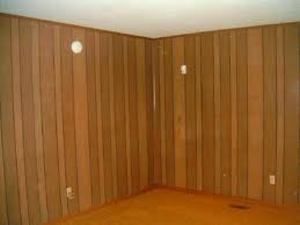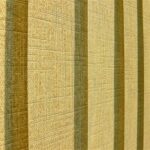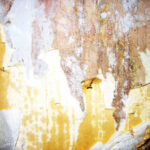Dark paneling can make a room appear closed in and small, which is why many homeowners choose to wallpaper over paneling. This is not a difficult task, but it does require a few additional steps than wallpapering a painted surface. In this article we will discuss how to wallpaper over paneling to achieve the best results possible.
There are two methods that work the best when you wallpaper paneling. The first is to use a wall liner paper, which we will discuss in a moment. The second is to fill in the grooves between the paneling with joint compound. Both of these methods will produce the same smooth look, it is a matter of person preference regarding which route you choose to take. Follow the steps listed below for both ways to wallpaper over paneling.
How to wallpaper over paneling – Option 1
Wall liner paper – By covering the paneling with a wall liner paper, you will be applying a very heavy-duty thick paper that makes the lines and groves in the paneling virtually invisible. This product is available at most home improvement stores, specialty wallpaper stores and online. We were able to find a variety of pre-pasted and unpasted wall liner at Steve’s Blinds and Wallpaper website. Here’s how to wallpaper over paneling using this method:
STEP 1 – Measure the wall space carefully to find out how much wall liner you will need to purchase. Don’t know how to measure for wallpaper? Read more here.
STEP 2 – Each bolt of wall liner varies in size, so be to check the packaging. Because there is no pattern repeat with wall liner, you will not need to take that into account when ordering.
STEP 3 – If you have purchased unpasted liner, you will need to apply vinyl adhesive to the back of the liner. Pre-pasted liner will need to be booked (soaked in water) according to package directions.
STEP 4 – Unlike regular wallpaper, liner is hung horizontally (side to side). By installing the liner in this direction, you will eliminate the dilemma of having two sets of wallpaper seams butting up against each other when your project is complete. This will create a smooth look similar to what you would have if you wallpapered over a regular wall.
STEP 5 – When choosing the actual wallpaper itself to go over the paneling, keep in mind that a textured wallpaper will work best. A smooth, flat wallpaper will look horrible because it will pick up any visible cracks or grooves. So remember, texture-texture-texture.
How to wallpaper over paneling – Option 2
Using joint compound to fill in the grooves of paneling is a bit more labor intensive than using a wall liner, but it is a less expensive option. The materials you’ll need to wallpaper over paneling using joint compound include a putty or spackle knife, joint compound, sandpaper, paintbrush and wallpaper primer. Then follow these steps:
STEP 1 – Fill in all the grooves and in any nail holes with joint compound. Smooth it out with the putty or spackle knife.
STEP 2 – When the joint compound dries, sand the surface well.
STEP 3 – Wipe off any excess residue from the paneling and repeat steps 1 – 3. The surface needs to be as smooth as possible when it is complete.
STEP 4 – Before you can hang the wallpaper, the area needs to be coated with a wallpaper primer. It goes on with a paintbrush, and applies like paint. This step can NOT be skipped! If the area is not primed well, the wallpaper will come off or pry away at the seams.
STEP 5 – Once the primer is completely dried, the wallpaper can be hung. Again, a textured wallpaper will work best to disguise the paneling. A paintable wallpaper is another good choice because it is highly textured and can be painted the color of your choice.
Related work by Jennifer Wagner:
How to Measure for Wallpaper
Wallpapered Ceilings – A Hot Trend in Interior Design
How to Wallpaper an Archway
SOURCE:
Personal knowledge and experience
Jennifer Wagner – Yahoo! Contributor Network
Steve’s Blinds and Wallpaper




